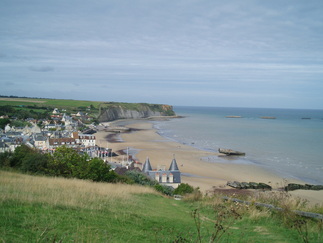 Arromanches – part of the Operation Overlord Normandy beach-head, where in June 1944 floating Mulberry Harbours, towed across the Channel from England, were linked to the beach by Bailey Bridges so that troops and military equipment could be landed safely.
Arromanches – part of the Operation Overlord Normandy beach-head, where in June 1944 floating Mulberry Harbours, towed across the Channel from England, were linked to the beach by Bailey Bridges so that troops and military equipment could be landed safely. When I found recently that a young graduate colleague of mine knew nothing about D-Day, I was quite shocked. That familiar old adage immediately springs to mind, what do they teach them in school these days? But then I guess you can’t convey everything in the short years at school, and things have moved on 40 years or so since I sat entranced in Mrs Wright’s history lessons at Tunbridge Wells Girls’ Grammar. Anyhow, I lent my young friend our DVD of Darryl F. Zanuck’s The Longest Day, which, with its superb international directors and cast, is in my view a pretty good introduction to the subject.
Incidentally, Richard Todd, with whom my father worked on Walt Disney’s Robin Hood in later years, played Major John Howard in The Longest Day, but actually took part in D-Day himself. There’s a fascinating account of some of his experiences on the excellent Pegasus Archive website.
Of the War Dead of Southborough and High Brooms, Tunbridge Wells, which I researched for my book on Southborough War Memorial, there are two men who were killed in action on D-Day and in the fighting that followed:
Private Reginald Francis, of Southborough, died on Tuesday 6th June 1944, aged 20. He was with the 7th Battalion of the Parachute Regiment, and he is buried in the Ranville War Cemetery, Calvados. Ranville was the first village to be liberated in France when the bridge over the Caen Canal was captured intact in the early hours of 6 June by troops of the 6th Airborne Division, who were landed nearby by parachute and glider. Many of the division’s casualties are buried in Ranville War Cemetery and the adjoining churchyard. The Pegasus Archive website includes a Roll of Honour for the 7th Battalion. Private Francis was one of 68 men who died on that day; 60 more were to die in the following weeks.
Private Ernest William Funnell, of High Brooms, fought with the South Staffordshire Regt, attached to the 13th (2nd/4th Bn, The South Lancashire Regt) Battalion, Parachute Regiment, Army Air Corps. He was killed during the assault of Hill 13 at Putot-en-Auge on Saturday 19 August, and was buried in the village cemetery along with 25 of his comrades. He was 24 years old.
Jerry Jones of High Brooms, a childhood friend, recalled that Ernie was one of a large family, and that before his war service, he worked for Frank (Dick) Dunn, at his piggery in Powdermill Lane. Ernie’s older brother Frederick is also commemorated on the Southborough War Memorial. Another High Brooms resident, Pete Simmons, recalls that Ernie’s younger brother was called up after the end of the war and killed in Korea.
Mr H Kershaw of Hove, East Sussex, after visiting the village of Putot-en-Auge and coming upon the War graves there, was inspired to research the history of the 5th Parachute Brigade’s action on D Day, which included the capture of the famous Pegasus Bridge:
At 16 minutes past midnight on the night of June 5 and 6, 1944, gliders landed near the bridge over the River Orne and the Caen Canal. The latter became famous as the Pegasus Bridge. Three minutes later the men of the 5th Parachute Brigade started to land. The gliders and the parachutists had to capture the bridges. Although lightly armed, they succeeded. It has been said that had these bridges not been captured and held, the Normandy landing may have been jeopardised.
After weeks of action near the coast, the Germans withdrew to the high ground overlooking the River Dives. This area included the village of Putot. The 5th Parachute Brigade was quickly in pursuit and arrived near Putot-en-Auge late on August 18. They launched a dawn attack and by 8.45am, against strong opposition, Putot was captured.
The brigade suffered many casualties who were temporarily buried in Putot churchyard. The War Graves Commission wanted to move these men to one of the large war cemeteries. The village opposed this, saying that these men died for us, so they should stay with us. A plaque displayed among the beautifully cared-for graves states: “The little town of Putot on Auge receives the parents, relatives, and friends of the soldiers lying in this cemetery with sympathy and gratitude.”
I’ve included an extract from Mr Kershaw’s detailed account of this first major battle to be fought during the German retreat in my book, and you can also find this linked to Ernest Funnell on my SWM Extra page.
Links/Sources:
The Longest Day – The Independent
Roll of Honour for the 7th Battalion in Pegasus Archive
Richard Todd's D-Day account in Pegasus Archive
Southborough War Memorial by Judith Johnson

 RSS Feed
RSS Feed
